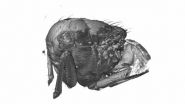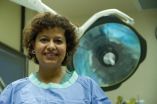(Press-News.org) (SALT LAKE CITY)—Millions of people worldwide – mostly women – suffer from recurrent urinary tract infections (UTIs) that seriously degrade their health and quality of life. Antibiotics treat individual infections, but preventing recurrent ones largely has been unattainable because of the way bacteria lodge in the inner layers of the bladder and quietly hide from drugs that can kill them.
In new studies with mice, however, researchers led by University of Utah microbiologists have shown that when chitosan, an FDA-approved compound for pharmaceutical, agricultural and other uses, is given in conjunction with antibiotics, it assists the bladder in ridding itself of "reservoir" populations of bacteria that live in its deeper layers and potentially cause recurrent infections. If the effectiveness of chitosan (ky-ta-san) against reservoir populations of bacteria could be confirmed in people, the compound might one day serve to augment antibiotic treatments of recurrent UTIs, according to Matthew Blango, Ph.D., a U of U postdoctoral researcher and first author on the study that appeared Tuesday, March 25, 2014, online in the journal PLOS ONE.
"Antibiotics don't do a good job of getting rid of reservoir populations," Blango says. "But when augmented with chitosan, there was a significant reduction in the level of bacteria in mouse bladders."
Matthew Mulvey, Ph.D., U of U professor of pathology senior author on the study. Elizabeth M. Ott, Ph.D., also a U postdoctoral fellow, is a co-author along with two researchers from the University of Ljubljana, Slovenia.
UTIs are responsible for nearly 10 million health care office visits, 1.5 million hospitalizations and $1 billion in costs annually in the United States, according to the National Kidney Foundation. The infections are more common in women, with one in five getting at least one UTI during her lifetime. Unfortunately, after the first infection, some people will get a second, third and fourth or more UTIs, with each successive infection making them more susceptible to recurrent episodes.
The urinary tract comprises the kidneys, bladder, uretha and ureters. UTIs are caused primarily by bacteria known as uropathogenic Escherichia coli (UPEC), which originate in the bowel but move into the urinary tract. UPEC often are susceptible to antibiotics, but they also have the ability to pass through the surface lining in the bladder and permeate into deeper layers of cells and tissue where they lie dormant and invulnerable to drugs. Periodically, though, UPEC bacteria replicate in the tissues, which may cause recurrent UTI flare-ups in people.
To destroy reservoir populations of UPEC, Blango, Mulvey and their colleagues infused mouse bladders with chitosan for 20 minutes, during which time the compound worked to exfoliate large cells lining the surface of the bladders. The exfoliation of cells did not harm the deeper layers of the mouse bladders but caused dormant reservoirs of UPEC to move toward the surface of the bladders and divide and replicate, making them susceptible to antibiotics.
The researchers followed up the chitosan by giving the mice a one-week course of fluoroquinolones, an antibiotic class commonly used to treat UTIs. A week later, when they checked the level of UPEC in the mouse bladders, Blango and his colleagues found the reservoir populations of the bacteria for the most part were gone.
"Effectively, there were no bacteria in the bladder," Blango says.
The mouse bladders also regenerated the surface lining of exfoliated cells in about a week.
The results in mice don't mean that people with recurrent UTIs can or should start taking chitosan with antibiotics. Large-scale trials with people would be needed to verify the efficacy of the compound in humans. Blango's and Mulvey's colleagues in Slovania are looking into that prospect, while the U of U researchers are interested in refining and improving the results in mice.
INFORMATION:
To access this study go to http://dx.plos.org/10.1371/journal.pone.0093327 at publication.
A way to end recurrent urinary tract infections? Study with mice gives hope
2014-03-25
ELSE PRESS RELEASES FROM THIS DATE:
EEG study shows how brain infers structure, rules when learning
2014-03-25
PROVIDENCE, R.I. [Brown University] — In life, many tasks have a context that dictates the right actions, so when people learn to do something new, they'll often infer cues of context and rules. In a new study, Brown University brain scientists took advantage of that tendency to track the emergence of such rule structures in the frontal cortex — even when such structure was not necessary or even helpful to learn — and to predict from EEG readings how people would apply them to learn new tasks speedily.
Context and rule structures are everywhere. They allow an iPhone user ...
In-fly movie: 3D video from inside flying insects
2014-03-25
VIDEO:
This is a 3D movie of a blowfly's flight muscles moving created by Oxford University and Imperial scientists using a new X-ray scanning technique.
Click here for more information.
The flight muscles moving inside flies have been filmed for the first time using a new 3D X-ray scanning technique.
3D movies of the muscles were created by a team from Oxford University, Imperial College London, and the Paul Scherrer Institute (PSI), using the PSI's Swiss Light Source, ...
Strictly limiting hours surgical residents can work has not improved patient safety
2014-03-25
TORONTO, March 25, 2014--Strictly limiting the number of hours surgical residents can work has not improved patient outcomes but may have increased complications for some patients and led to higher failure rates on certification exams, a research paper concludes.
Traditionally, doctors in the residency phase of their training spent very long hours in a hospital –often around-the-clock--so they could see a wide variety and high volume of patients. In the last 10 years, health authorities started limiting those hours in the hopes of improving patient safety and the education ...
Unravelling nerve-cell death in rare children's disease
2014-03-25
LA JOLLA, Calif., March 25, 2014 — A team of scientists, led by Stuart Lipton, M.D., Ph.D., professor and director of the Neuroscience and Aging Research Center at Sanford-Burnham Medical Research Institute (Sanford-Burnham), recently discovered why cerebellar granule cell neurons in patients suffering from ataxia-telangiectasia (A-T) were unable to repair DNA damage and thus died.
A-T is a hereditary condition that begins early in childhood, and causes a gradual loss of certain nerve cells in the cerebellum of the brain. A-T occurs in about 1 in 40,000 births, with symptoms ...
Brain differences in college-aged occasional drug users
2014-03-25
Researchers at the University of California, San Diego School of Medicine have discovered impaired neuronal activity in the parts of the brain associated with anticipatory functioning among occasional 18- to 24-year-old users of stimulant drugs, such as cocaine, amphetamines and prescription drugs such as Adderall.
The brain differences, detected using functional magnetic resonance imaging (fMRI), are believed to represent an internal hard wiring that may make some people more prone to drug addiction later in life.
Among the study's main implications is the possibility ...
Penn study: Distance from designated VA liver transplant center linked with greater risk of death
2014-03-25
(PHILADELPHIA) – Veterans with liver disease who live more than 100 miles from a Veterans Administration hospital that offers liver transplants are only half as likely to be placed on the liver transplant waitlist to receive a new organ compared to veterans who live closer to transplant centers, according to a new study from the Perelman School of Medicine of the University of Pennsylvania. The findings, which are published in the March 26 issue of JAMA, also reveal that the further liver disease patients live from these five transplant centers, the more likely they are ...
Treatment helps reduce risk of esophagus disorder progressing to cancer
2014-03-25
Among patients with the condition known as Barrett esophagus, treatment of abnormal cells with radiofrequency ablation (use of heat applied through an endoscope to destroy cells) resulted in a reduced risk of this condition progressing to cancer, according to a study in the March 26 issue of JAMA.
In the last 3 decades, the incidence of esophageal cancer has increased more rapidly that other cancers in the Western world. This type of cancer often originates from Barrett esophagus, a condition that involves abnormal changes in the cells of the lower portion of the esophagus, ...
Web-based alcohol screening program shows limited effect among university students
2014-03-25
Among university students in New Zealand, a web-based alcohol screening and brief intervention program produced a modest reduction in the amount of alcohol consumed per drinking episode but not in the frequency of drinking, overall amount consumed, or in related academic problems, according to a study in the March 26 issue of JAMA.
Unhealthy alcohol use is common among young people, including university students. Using an internet site to screening students for unhealthy alcohol use and intervene if appropriate has been suggested as an inexpensive means of reaching large ...
Effect of distance from transplant center on outcomes
2014-03-25
Among veterans meeting eligibility for liver transplantation, greater distance from a Veterans Affairs transplant center or any transplant center was associated with lower likelihood of being put on a waitlist or receiving a transplant, and a greater likelihood of death, according to a study in the March 26 issue of JAMA.
Centralization of specialized health care services is used to control costs, concentrate expertise, and minimize regional differences in quality of care. Although efficient, centralization may offset gains in care delivery by increasing the distance ...
Blood glucose measure appears to provide little benefit in predicting risk of CVD
2014-03-25
In a study that included nearly 300,000 adults without a known history of diabetes or cardiovascular disease (CVD), adding information about glycated hemoglobin (HbA1c), a measure of longer-term blood sugar control, to conventional CVD risk factors like smoking and cholesterol was associated with little improvement in the prediction of CVD risk, according to a study in the March 26 issue of JAMA.
Because higher glucose levels have been associated with higher CVD incidence, it has been proposed that information on blood sugar control might improve doctors' ability to ...


